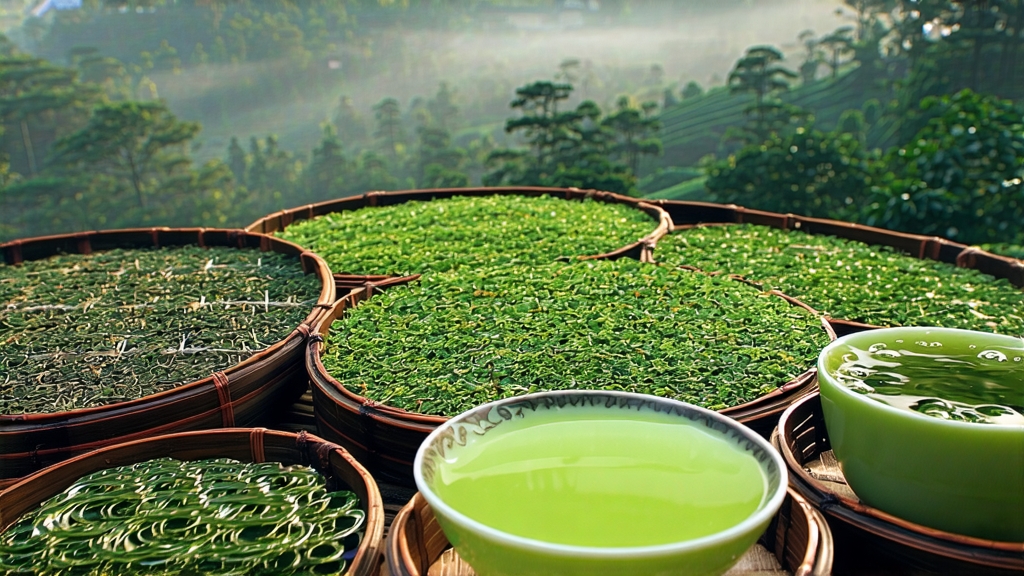
Biluochun, whose name translates literally to “Green Snail Spring,” is one of China’s ten most celebrated teas, yet it remains a delicate secret outside serious tea circles. Grown on the mist-lapped islands and peninsulas of East China’s Taihu Lake, this jade-green tea is prized for its tiny spiral-shaped leaves, an intoxicating bouquet of apricot and orchid, and a sweetness so persistent that poets once described it as “a dewdrop that refuses to leave the tongue.” To understand Biluochun is to step into a microclimate where lake, fruit, and tea bush converse every March, then to witness a craft so precise that a single kilo demands sixty thousand hand-plucked shoots.
History whispers that Biluochun was first noticed by monks during the late Tang dynasty, when wild tea trees growing among peach, plum, and apricot trees began to absorb the fragrance of neighboring blossoms. The tea was originally called “Xia Sha Ren Xiang” (“scary fragrance”) because its aroma was almost too seductive for mortal senses. Legend credits Emperor Kangxi of the Qing dynasty with rechristening it “Biluochun” in 1699 after he saw the leaves unfurl in his cup like tiny green snails and decided the name better suited its elegance. From that moment, the tea became a tribute item, carried by fast horses from Jiangsu to the Forbidden City each spring.
Geography is destiny for Biluochun. The Dongting Dongshan and Xishan hills rise from Taihu like green tortoises sunning themselves; the lake’s 48 square kilometers act as a thermal regulator, shrouding the slopes in fog until midday. This humidity forces tea bushes to grow slowly, thickening cell walls and concentrating amino acids that translate into sweetness. Because the hills are too steep for tractors, farmers still climb narrow stone paths carved during the Ming dynasty, carrying bamboo baskets on their backs. The highest grade, Mingqian Biluochun, is picked before the Qingming festival when nights are still cool and shoots are barely two centimeters long—one bud plus one unfolding leaf, the so-called “sparrow’s tongue.”
Although all Biluochun comes from the same two hills, connoisseurs recognize three micro-origin styles. Dongshan Island teas, surrounded on three sides by water, acquire a marine minerality reminiscent of nori. Xishan Peninsula teas, wrapped by lake on one side and orchards on the other, carry a stronger floral lift. A third, newer category called “Wuzhong Highland” grows on terraces above 300 meters where colder nights add a white-wine crispness. Farmers further separate leaf grades by the speed of plucking: “Tou-cai” (first pick, 6 a.m.–9 a.m.) offers the softest down and palest liquor; “Zhong-cai” (midday) gives more body; “Wei-cai” (late afternoon) is chewier and suited to culinary infusions.
The crafting of Biluochun is a ballet of heat, pressure, and timing that unfolds within minutes of plucking. Leaves are first spread on bamboo sieves for two hours of withering, just long enough for the lake mist to evaporate without oxidizing the greens. Next comes “shaqing,” a killing-green step performed on a cast-iron pan heated to 180 °C. The tea master tosses a handful of leaves into the pan, then claps them between his palms in a motion called “tuan-rub,” rolling the shoots into tight spirals while simultaneously deactivating enzymes. Temperature drops by 20 °C every three minutes; the entire cycle lasts precisely seven minutes. Finally, the leaves are dried over a gentle charcoal fire made from local peach wood, whose smoke imbues a whisper of stone-fruit sweetness. When finished, a premium Biluochun resembles tiny jade snails covered in silvery down; if dropped on a glass table, the leaves bounce like miniature springs.
Water is the silent partner in any Biluochun session. Because the tea itself is so delicate, chlorinated tap water will bully its nuances. The classic choice is spring water from Tiger Hill, but filtered low-mineral water at 75 °C works abroad. A tall, thin glass—not a tiny gaiwan—allows the famous “tea dance” to be observed: when water hits the leaves, the spirals sink, then rise again as trapped air expands, pirouetting like green ballerinas. Use three grams for 250 ml, steep 45 seconds for the first infusion, adding ten seconds for